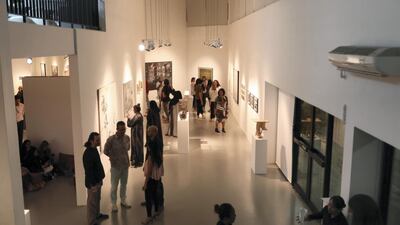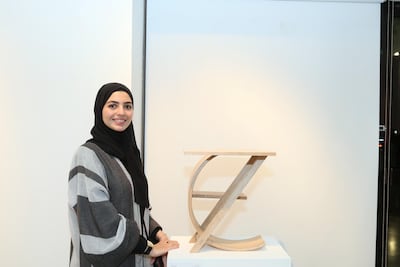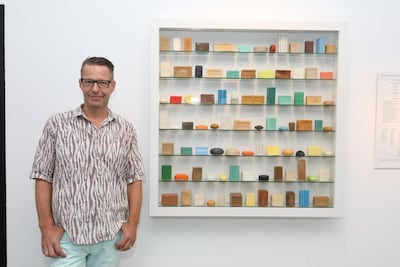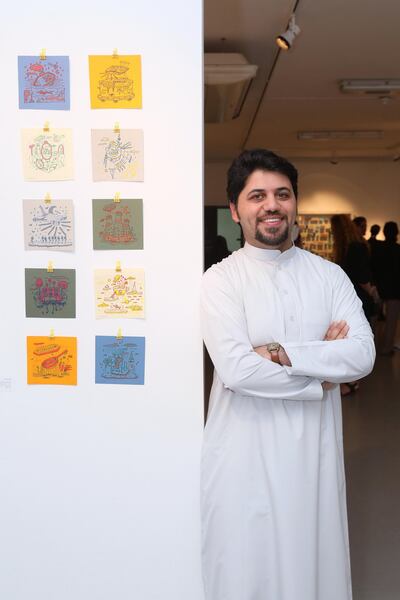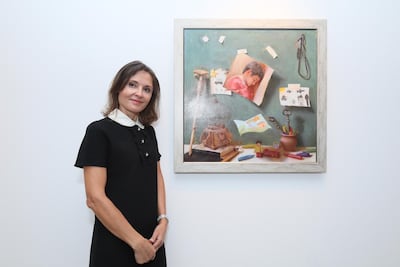"Tashkeel is first and foremost a place for work," writes Anabelle de Gersigny in a publication celebrating the organisation's first decade. "The only place, in fact, for an artist from anywhere in the world to arrive and be able to make, to use making as a way of engaging." It is no surprise then that their annual exhibition Made in Tashkeel is just as relevant now as it was in Tashkeel's early years.
The result of an open call, the exhibition is curated and shaped by senior management; its ninth year whittled down from 65 submissions to 38 works by 30 artists. Anyone with any connection to Tashkeel can apply, from their members to those who have participated in workshops or attended talks. "It's the culmination of a year's worth of work and a year's worth of thinking, observing and seeing," Deputy Director Lisa Ball-Lechgar says. "In order to curate this disparate group of works we have to have a 360-degree understanding of who these people are – where the subject matter has come from. It is important that we curate by consensus."
Studio Manager Tasmin Wildy agrees: "We receive an overwhelming amount of work," she tells The National. "It's a big mix. We put things up, look at them together and make connections. There isn't a theme, but interestingly the show has organically morphed into certain areas."
As we walk through the show, subtle links, particularly of materials the artists have experimented with, emerge. Firstly, it's natural forms and specifically wood: a rocking stool by Rasha Saffarini faces a fresco on wood by Chafa Ghaddar, in the centre sit exquisitely carbonised fruits and fish skulls placed in and around wooden display cabinets, a work by Elle Ford. Sharing an elegiac sensibility is Jalal Bin Thaneya's large photograph Scrap Yard I. Hung on the back wall, it concludes a metallic theme that is first hinted at by the gold frames of Hamda Al Falasi's mixed-media photographs, before the exquisite Hejazi Moths by Hadil Moufti – a celebration of all things shiny using gold and silver leaf, Azza Al Qubaisi's Al Joud series of gold jewellery and Kay Li's Mushin, made of metallic foil on natural fabric.
Li's piece is a clear example of how the community of Tashkeel can impact an artist to work in new ways. "Mushin is a collaboration of everybody," the Hong Kong-born fashion designer tells us. Now working full time from Tashkeel, she established her label in 2012. Fruitful exchanges with Moufti resulted in Li using gold foil, but her major breakthrough came from UK artist Fay McCaul, who was on a residency in Tashkeel last winter. "On the day she was leaving, I asked her to teach me how to use a heat press," Li says. "It worked so I thought, how am I going to do this as a big piece?" What followed were weeks of trial and error, of learning how to screen print, of how to fix gold foil, experimenting with types of glue that make the fabric soft and also wearable.
Her findings will inform her next collection, but the piece stands as a pure form of artistic creation apart from her commercial work. The Zen-inspired title, minimal expression and symmetry hark back to her Chinese heritage. “This process had made me understand I like art a lot,” Li says. “I always liked patterns and parallel lines given my mathematics and computer background, but this free-form is instinctively drawn”.
The second gallery introduces a more vibrant palette, kicked off by Saher Nassar's Keith Haring-inspired pink canvas of a cartoon-like running-form clutching a heart, rounded off by Tor Seidel's mesmerising Damien Hirst-like clinical cabinet of soaps on the back wall. The mural We Breathe the Sea by artist Myneandyours, which is in the d3 car park, has been photographed by Jo Askew, and is on display together with preliminary drawings of the piece.
Ten examples of Nasir Nasrallah's The Atlas of Imaginary Places are pinned up: these risograph prints are available for purchase from The Stories Vending Machine, an ongoing project by the artist. (The risograph technique is a particularly popular one and subject to around two workshops a month.)
A trio of works show the ways Arabic calligraphy is being explored today, from a canvas by Wissam Shawkat, whose modern approach breathes energy into free-flowing forms, to a poster by Ibraheem Khamayseh, Tashkeel's in-house senior graphic designer.
Sitting between is Amal Al Gurg's Sawtu Safeer Al Bulbuli, a beautifully presented screen print telling an old oral Arab parable. An early Tashkeel member, Al Gurg's background is graphic design, but her interests have shifted to calligraphy and now typography after participating in a workshop organised by Tashkeel with the Khatt Foundation in November.
_________________
Read more:
Celebrating 10 years of the pioneering arts hub Tashkeel
Four books that every Arab art fan should read
Art in the UAE: the exhibitions and installations to look out for in 2018
_________________
The show culminates with a lively video installation and majlis-style seating area by Hind Mezaina and Tulip Hazbar. "Coming from both a performing arts and a visual arts background, I feel it's very important that a gallery is no longer a silent chapel to artistic practice," Ball-Lechgar says as we study this piece. During the opening, it created a real buzz in the audience. "The gallery should be as vibrant as what goes on in the studios around, so to bring in music, to bring in movement, to bring in other disciplines of artistic expression is very important." She concludes by disclosing: "Moving forward, we plan to further integrate interdisciplinary as well as multi-disciplinary discourse."
A few moments earlier, we had stopped to look at Fallen Dreams by Fatima Atallah, an oil painting on linen that, in its precise technique and symbolic subject matter, reminded me of still life paintings produced in 17th century Holland by artists like Carel Fabritius (known for The Goldfinch). "Sometimes conventionally-trained classical artists are left out of the contemporary art dialogue" Ball-Lechgar says. "Our challenge is to help these incredibly gifted artists find a new voice".
And there lies the beauty of Tashkeel, always gently pushing forward, encouraging new modes of production while continuing to support traditional practices.
